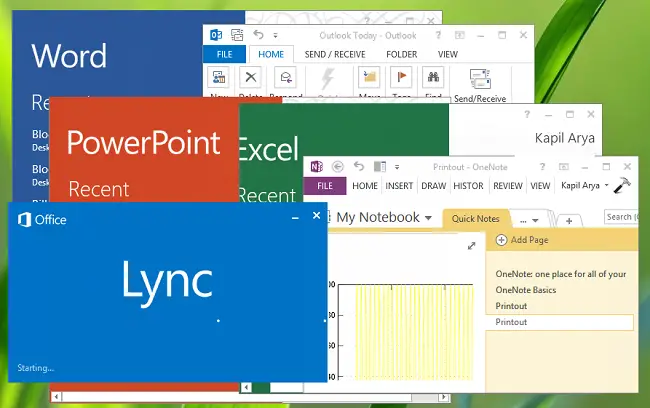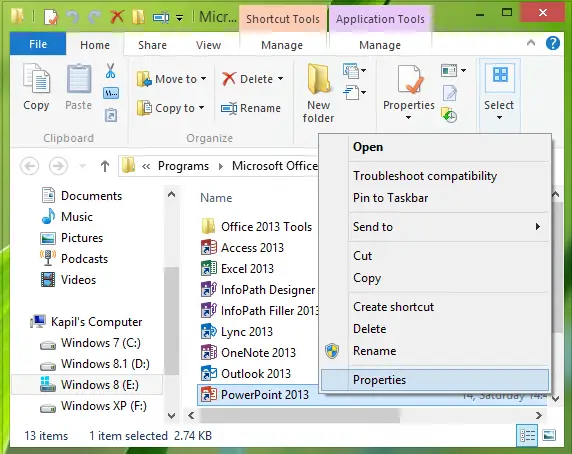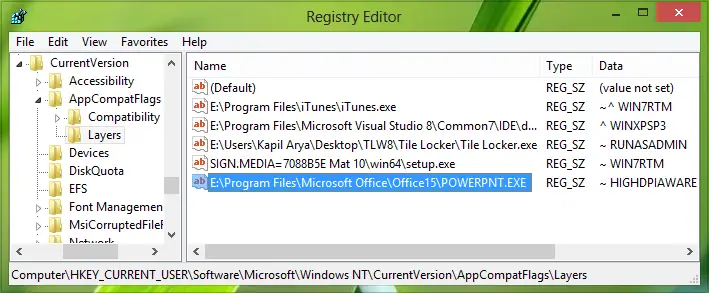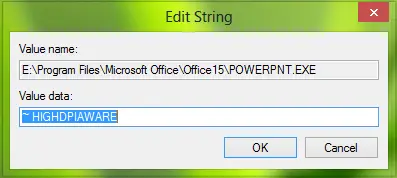To match the theme of Windows 11/10, Microsoft Office 2021/19 also follows the same UI concept. DPI Scaling plays an important role in using programs with Modern UI. When the scaling is not properly configured, fuzzy and blurry content occurs. Poor Display Scaling makes the programs look quite bad.
Dots Per Inch (DPI) Scaling is one of the additional features introduced in Windows 11/10 regarding the projection of the display to external devices. For a specified resolution, say 1366×768 pixels, the DPI Settings must be above 100%.
DPI Settings are important when projecting the Windows Start Screen or Menu to a projector. If the DPI Settings remain below a predetermined level, the Metro tiles will lose their charm and fluidity and be displayed as mere boxes.
Fix Blurry Fonts in Office Programs

So how does one avoid poor scaling of Office components?
Well, you can try disabling external monitors and see if it helps. Or you can try using the Compatibility option. If these do not work, you can try this method.
1. Open your Microsoft Office installation folder. Right-click on the icon of the Office program for which you’re facing the issue of poor scaling and select Properties.

2. Now in the Properties window, switch to Compatibility tab and put a check mark against Disable display scaling on high DPI settings. Click Apply followed by OK.

Now, reopen the Office programs, and you will find that their content will not be blurry.
There may be a possibility that you may find that the option is disabled or grayed out. In such a case, you will manipulate the concerned registry setting. To do so, press Windows Key + R combination, type put Regedt32.exe in Run dialog box and hit Enter to open the Registry Editor.
2. Navigate to the following location:
HKEY_CURRENT_USER\Software\Microsoft\Windows NT\CurrentVersion\AppCompatFlags\Layers

3. In the right pane of this location, create a new string value using Right-click -> New -> String Value. Name this string so created as the file location of your Office component program.
For instance – say PowerPoint, – in my case it’s located at E:\Program Files\Microsoft Office\Office15\POWERPNT.EXE.
Now double click on the same string to modify its Value data:

4. In the Edit String box, put the Value data as ~ HIGHDPIAWARE. Now, close the Registry Editor and reboot the machine to make changes effective. After reboot, you won’t see poor scaling issues with Office programs.
You may also try the following. From the Office program options, under the Advanced section, check the Disable hardware graphics acceleration setting and see if it helps you.
For eg. open Outlook > File Options > Advanced > Display > Check the Disable hardware graphics acceleration box > OK. Restart your computer.
I hope something helps.
Read: How to make Font blurry in Word
You may want to also check this post on how to Disable DPI virtualization or Lower the overall Windows DPI setting system-wide to resolve such issues.
Why do the letters on my screen look blurry?
Blurry text on your screen often occurs due to scaling issues with high-resolution displays, like 4K monitors. Windows scales text to improve readability, but this can sometimes cause blurriness. Adjusting display settings or updating drivers may help resolve this issue.
How do I fix Blurry screen in Outlook?
To fix a blurry screen in Outlook, go to File > Options > Advanced > Display and check the box that disables hardware graphics acceleration. Restart Outlook to see if the issue is resolved. If everything is fixed, you can uncheck the box again after some time.
Additional readings to help with the issue of blurry fonts:
- To fix the issue of Blurry Fonts in Windows.
- Make text easier to read using ClearType Tuner in Windows.
I have tried these suggestions and it made absolutely no difference.
Text rendering in Office 2013 Word documents, Outlook email and Excel spreadsheets is still terrible.
^^ Odd, have you tried to change these settings from Office programs native options mentioned in last lines of article?
Yes.
The problem is not scaling.
It is the awful grey-scale font anti-aliasing that IE11 and Office 2013 force upon us.
Microsoft deliberately removed the option to use RGB font anti-aliasing to display web pages and Office documents/spreadsheets etc, even though the user interface itself largely still uses RGB font rendering.
^^ In that case, are you able to get the fix working after disabling font aliasing:
https://www.thewindowsclub.com/disable-font-smoothing-windows
Thank you so much for posting the suggestion on disabling the scaling on high DPI settings. I’m running Office 2010 on a Windows 8.1 machine using an external monitor and this change made a HUGE difference in the clarity of text and menus in Outlook, Word, and Excel.
^^ Thanks for feedback :)
Thank you for this guide. I had to use registry method but it makes a huge difference when I use Office on external display
I tried disabling ClearType completely as per the instructions you referenced.
The effect was that the user interface of all programs was no longer smoothed.
However, Internet Explorer 11 completely ignored my settings and was exactly the same as before. Ironically, IE 11 ‘s menus etc used the non-aliased font but for website content, it continued to force its awful grey-scale font anti-aliasing.
Office 2013 did render documents without anti-aliasing. So did Firefox.
However, the non-smoothed fonts looked quite bad so I have re-enabled ClearType.
Since my original post, I have reverted to Windows 7 and Office 2010 and my fonts are perfectly clear.
I only boot Windows 8.1 up occasionally to see if Microsoft have released an update to fix the terrible font rendering.
^^ In that case, you can try other methods mentioned in article itself :)
^^ Hope you might have installed following update, it fixed the issue for many, regarding PowerPoint:
https://support.microsoft.com/kb/2817625
That update was already on my system.
Thanks! This made a big difference!
^^ Cool :)
A recent Windows 8.1 update installed and triggered the blurriness in Outlook 2013. Thankfully this fixed it!
Thanks!
^^ Thanks for sharing this :)
Thanks a million! Works perfectly…
Thank you !
This worked perfectly on my Yoga 2 Pro with dual monitors.
^^ Glad we could help :)
Are there any new possible fixes? I just installed Office 2013 on two different machines: Win 7 and Win 8.1. Both have the blurry font issue in Outlook, Word, Excel… It’s not horrible but it’s definitely there. Directly compared to Office 2010 it is horrible actually. :( All other applications on both machines are fine. That’s definitely an Office 2013 issue. I can’t believe that MS didn’t release a fix so far. Any ideas?
I couldn’t find a compatibility tab after clicking Word 2013 (shell:Common FilesMicrosoft). I have heard that Office 2013 has disable the compatibility tab in Window 8.1. Please help! The text of my word document look fuzzy.
I have successfully changed and improve the text from the fuzzy problem in Chrome using your instruction. Thanks for that!
Hi, I have Windows 8.1. with Office 2013 from Office 365. Don’t seem to have a Layers folder in HKEY_CURRENT_USERSoftwareMicrosoftWindows NTCurrentVersionAppCompatFlags. Any ideas?
There’s no compability tab when I clicked properties.. I’m using Windows 8.1 and Microsoft 2013.
Windows 10, still the same problem..OFFICE 2013=blurry fonts, unbelievable…
have any of you found the solution to this?
i have half a mind to reinstall office 2010
Any solution to get the tab there? A workaround might be: right click >> troubleshooting.
I have the same problem. Is there any progress on fixing this? I’m getting really tired of not being able to scaled on high DPI monitors….
awesome sharing by KapilArya. Thanks Kapil
However, I could not find the prorgam in the registry, but I did locate the programs.
Windows 8.1 allows for an easier solution.
Right click on the program, click test compatibility.
Select the option: troubleshoot compatibility
Troubleshot program ->select: The program opens but doesn’t display correctly
Click Next, click Test the Program.
It will run some diagnostics and open up the program (powerpoint for example)
If you are happy with it, click: Yes, save these settings for this program.
A box stating troubleshooting has completed.
For some reason I do not have the Compatibility tab!!! :(
this worked for me.
in my portuguese windows the option “the program opens but doesn’t display correctly…” is truncated so it was confusing at first – i thought I wouldn’t have the right option…
win10, no compatibility tab, didn’t want to bother with the registry editor solution (had bad experiences in the past when creating new keys…)
Thank you! The “display scaling” checkbox did the trick! It looks soooo much better now.
Thank you for essentially saving my monitor! The compatibility checkbox worked. 4 years of word being completely fuzzy. Sorted.
Thank you!
WORKS!!!
Thank you! It totally works!
Kudos on your clear article. The first solution worked for me. More importantly, I’ve been trying to solve my mixed-resolution, multi-monitor setup (1 x 3840×2160 and 2 x 1200×1920) for more than a month and this was the first article out of many I have tried that actually worked. I know my way around a PC but I didn’t realize that Office products had a Compatibility Mode. You certainly don’t heard about it on the Microsoft site. Thank you, thank you!